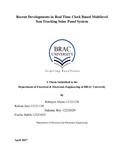Real time clocked based multilevel solar system
Abstract
Solar energy has been considered as a feasible source of renewable energy over the past few decades as it has been and is still being used to power up our industrial and domestic applications and gain desired national production. Bangladesh, like some other third world countries, demand of energy is higher than the production met by the power sector, even after considering only 70% of the population who are hitherto under electricity coverage of national grid. The result of this shortage is load-shedding, and the people of urban areas suffer the most from it because of their dependency on electricity for daily activities. Although solar energy can be used to reduce the energy crisis of Bangladesh, the limited space for setting enough photovoltaic (PV) panels to meet the demand of city dwellers emerges as a constraint in implementing solar energy system in densely populated urban areas. A modified structure equipped with a rotating and sliding mechanism holding three solar panel has already been implemented. The panels are stacked one above another in a rack to minimize floor area, and track the sun using sun tracking system to maximize power generation. Now, the thesis will focus on collecting data using an automated data logger and verify the claims of the proposed system by analyzing those data. Also we include multilayer reflector to enhance the output power. The reflector is equipped with actuator to measure the right angles depending on the latitude and longitude depending on the seasons and locations. We hereby compare the reflector taken data. The implementation has been done by constructing a physical structure equipped with servo motors controlled by microcontroller to rotate the panels on a horizontal axis. The panels are supported by a metal rod fixed at a tilted angle equal to the latitude among north-south direction facing south (23°). The panels rotate throughout the day from sunrise to sunset through servo motors controlled by microcontroller. It allows rotation of the three panels on a fixed horizontal axis to track the sun at hourly intervals and maximize power generation. The entire position of the three panels is changed by the actuator after midday when the sun moves from east to west. The microcontroller determines the appropriate position of maximum power absorption for a particular time using a real time clock and a set of equations. The data of current and voltages of each panel will be collected using a data logger device developed for this purpose. The collected data will then be analyzed, which will show a high level of conformity to the theoretically calculated values. The projected system will give a worthwhile solution to electricity problems in urban areas where space is inadequate.

